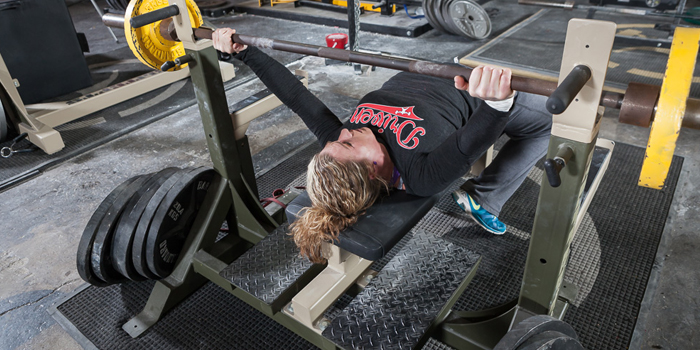
Sometimes your training buddies bail. Your work schedule sucks. You have to train at home during a global pandemic. Whatever the reason you’re training solo, it doesn’t mean you have to ditch your max effort work.
Variations with Minimal Equipment
There are a plethora of articles with suggestions for max effort variations when you don’t have access to a full arsenal of crazy bars and shit to hang from them. Not to worry! You can have tons of fun with the basics. We’re going to assume that you have the basics like a straight bar, a rack, a bench, a box, boards, some bands, and some chains. You don’t have to think too far outside the box to come up with variations on the SBD:
Squat
- Stance width (narrow, medium, wide)
- Bar placement (high, low)
- Box or free squats
- Box height (high, at depth, low)
- Front squat
- Zercher squat
- Reverse band, against bands, bands pulling from the front
- Chains
- Any type of good morning variation (any variation of the lift and also the set up ie suspended).
Bench
- Grip width (close, regular, wide)
- Boards
- Reverse band, against bands
- Chains
- Dumbbells
- Floor press
- Pin press
Deadlift
- Conventional, sumo or any variation
- Deficit, rack/mat pulls
- Against bands, reverse bands
- Chains
Now to the safety considerations, first and most obvious, set the safeties/pins to catch you. Now that we got that out of the way, work up to a heavy single FOR THAT DAY.
RECENT: 4 Ways to Mentally Master Your Meet Performance
This is a concept that everyone who works up to a max effort single should understand but alas, a lot of us have the luxury of spotters and therefore we have the luxury of making stupid decisions and missing lifts. Your heavy single is based on what is heavy FOR THAT DAY. Not what you THINK you should get. Not what you did last year while peaking for a meet. The point of max effort work is to work through a heavy rep, strain with relatively good technique, and to think and adapt under a heavy load. Keep that in mind as your goal for the day.
If you can beat a PR on a variation, then great. If not, it doesn’t mean you failed for the day. Did you hit a heavy single and work to keep your form under the load? Then mazel tov, you succeeded.
You may be beat walking into the gym, you might be coming off a long deload if you were sick, you might be far away from a meet and your strength level isn’t at its highest. Get your ego out of the way and get to work. What matters is how you perform on the platform. Your strength will thank you if you get some good heavy work in every session as opposed to warming up then missing a PR every week. Keep in mind that the end goal is the meet. Everything else just builds up to it.
Take Smart Jumps
Don’t put yourself in a position where you greatly overestimate the next jump you should take and end up flailing with the bar on your chest gasping “help me” inaudibly and the only one to hear you is your cat (who just wants to watch you die, BTW).
Learning how each set feels and what jump to take is a learning process for sure. But you can set yourself up for success by taking small jumps. Use the 10s and 5s and even 2.5s. Err on the side of caution. You want to be certain that you can get your next rep.
You want to end up taking 1-3 heavy working sets for the day so keep that in mind while you are working up. You don’t have to jump straight from a warm-up set to your max single. Get the work in. Taking small jumps won’t hurt you there. Try to think in terms of getting heavy sets in as opposed to working up to X amount of weight.
The weight can autoregulate itself.
You can choose exercises where you still strain but the weight is limited by the movement itself. You can still do a hard and heavy max effort movement without using 90%+ of your max squat. For instance, exercises like a close stance yoke bar low box squat, floor press, dumbbells, and good mornings will inherently use less weight than your straight bar squat and bench (I’m not that worried about anyone getting stapled with a deadlift). Try to think in terms of the overall load you are handling. Furthermore, you don’t always have to hit a single. Triples or doubles on good mornings will be at a lower weight than what you could hit for a single.
To Accommodate or Not?
Just because you’re training by yourself doesn’t mean you need to stick to straight weight. However, unless you are experienced with certain band setups, I would recommend sticking to chains if you want to add a little spice to your lifting life. Bands can very quickly catch up to you. Meaning one set is fine and the next you get totally stapled three-fourths of the way up your squat even if you only added a little bar weight. If you don’t have a spotter, that’s a ticket to spine pound town. Bands can also throw you off your groove/pull you around more easily than chains. Chains don’t catch up with you as quickly as bands. You may hit a point where all the bands kick in but you can keep grinding or at least hold it instead of having the bar come careening back to your body when you’re benching. Don’t forget you can also take half chain jumps if you’re going up in chain weight!
Don’t be afraid to get in a little me time while you’re training alone! Let me know what other tips you have for solo sessions in the comments!











1 Comment